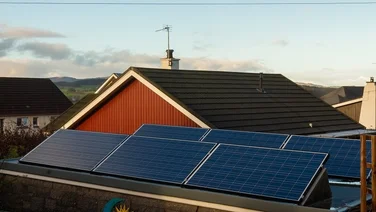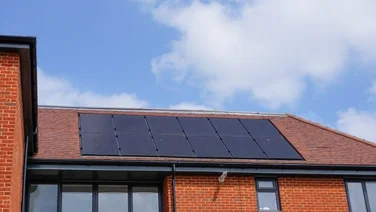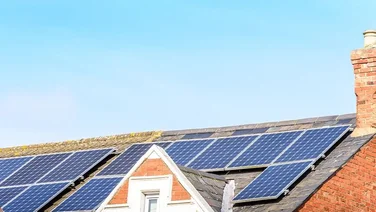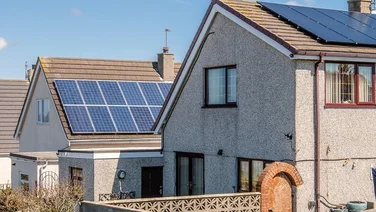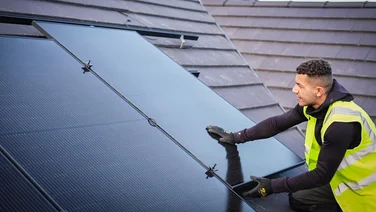- Solar panels can power electric underfloor heating systems
- Wet underfloor heating can be fuelled by solar thermal panels
- Solar-powered underfloor heating costs £5,000 – £6,000 on average

Solar-powered underfloor heating can save you money on your energy bills, which is a great thing considering the price of solar panels and uncertain energy markets.
Solar-powered underfloor heating is just one of the many ways you can use solar to cut bills and carbon emissions.
We’ll go over what solar-powered underfloor heating is, how it works, and how it’s installed in this article. We’ll also go over the costs, and the advantages and disadvantages.
What is solar-powered underfloor heating?
Solar-powered underfloor heating is self-explanatory. It is placed under the floor and heats your home with solar energy in the form of either solar thermal panels or solar photovoltaic (PV) panels.
There are two main types of solar-powered underfloor heating: electric underfloor heating, and wet underfloor heating.
Solar-powered electric underfloor heating
Solar-powered electric underfloor heating consists of electric heating mats or cables, which are installed under the flooring.
This equipment converts electricity into heat to warm your floor, and can be powered by energy generated by solar PV panels.
Unfortunately, since solar panels only produce energy during the daytime, they won’t be able to power the electric underfloor heating after dark. In the evenings and night time, you’ll have to use electricity from the grid to keep the system running.
Alternatively, you can invest in a solar battery, which stores excess electricity generated by your solar panels during the day to use at night.
Solar-powered wet underfloor heating
Solar-powered wet underfloor heating, or hydronic underfloor heating systems, consist of pipes placed under the floor, through which hot water is sent. It uses hot water in a similar way to radiators.
Wet underfloor heating systems can be powered by solar thermal panels, or you can use solar PV panels to supply the energy for an electric water heater.
Solar thermal panels are essentially solar panels that use the sun’s energy to heat water, which can be used in radiators, underfloor heating, and bathrooms. The hot water is stored in a thermal cylinder, which keeps it warm.
Wet underfloor heating systems that are paired with a solar thermal setup usually require a backup boiler or heat pump, since the thermal panels won’t be able to provide enough hot water for continuous heating.
It’s generally recommended that you leave wet underfloor heating on at night during the coldest months, because it can take a few hours to get going. The best course of action is to lower the temperature at night, then turn it up in the morning.

Pros and cons of solar-powered underfloor heating
- Cheaper running costs than when not using solar energy
- Eco-friendly energy source
- Energy efficient
- Safe form of heating
- Expensive upfront costs
- Wet underfloor heating takes a while to heat up
- Often requires a backup system
What are the benefits of solar-powered underfloor heating
The main advantage of solar-powered underfloor heating is the running costs are cheaper, as both solar PV and solar thermal panels use free energy from the sun to power your heating system. Plus, solar energy is eco-friendly. Powering your heating with solar energy can help reduce your carbon footprint.
It’s estimated that wet underfloor heating is 15% to 25% more efficient than radiators. Because the underfloor heating system covers a large area, the pipes or coils below the surface don’t need to get as hot as radiators to heat a room, meaning they can use less energy.
This low-level heat is also what makes underfloor heating a very safe way to warm your home. Radiators can get very hot, and can cause burns when touched. Underfloor heating doesn’t get as hot, and since the pipes or coils are buried under the floor, you’ll never accidentally come into contact with them.
Is there anything else I need to consider?
The main disadvantage of solar-powered underfloor heating is its high upfront costs. Underfloor heating on its own can cost upwards of £1,000 per room. When combined with additional solar PV or solar thermal panels, the total cost can climb up to £7,000.
Wet underfloor heating paired with solar thermal can also take a while to heat up. You’ll need to wait five and six hours for solar thermal to fully heat up your storage cylinder. And it can take an additional hour or so for that water to reach the underfloor heating pipes and warm a room.
Additionally, because both solar thermal and solar PV panels depend on daylight to generate energy, you can’t rely on them to power your heating full-time. If your underfloor heating is electric, you’ll have to use grid electricity when it gets dark. If you use wet solar thermal heating, there will be times when you might need to rely on your boiler.
How much does solar-powered underfloor heating cost?
Floor surface size | Electric underfloor heating cost | Wet underfloor heating cost |
|---|---|---|
10 m² | £500-£850 | £1,200-£1,850 |
15 m² | £750-£1,275 | £1,800-£2,775 |
20 m² | £1,000-£1,700 | £2,400-£3,700 |
The overall cost of electric underfloor heating with solar PV is £5,316 on average, while wet underfloor heating paired with solar thermal typically costs £6,450.
On its own, electric underfloor heating costs between £500 and £1,700. Wet underfloor heating is more expensive, costing between £1,200 and £3,700 to buy and install.
Using solar energy to run your underfloor heating system will add to the overall costs.
One 350-watt solar PV panel costs £703 on average, to buy and install. How many solar panels you need to power just the underfloor heating system will depend on its size, but the average 1-2 bedroom home needs at least six, which costs around £4,216.
The running costs of solar-powered electric underfloor heating are roughly £229 a year for a 10 m² system, and £343 for a 15 m² one. That’s around 50% less than you’d pay without solar PV.
Wet underfloor heating that uses solar thermal panels and a boiler as a backup system costs around £57 a year to run, for a 10 m² system. A 15 m² system costs around £85 a year. Solar thermal, like solar PV, reduces your running costs by around 50%.
Solar-powered electric underfloor heating is more expensive to run than wet underfloor heating, because electricity is more expensive than gas. It’s possible to heat a whole house with underfloor heating, although this is generally done in new builds rather than existing homes as the process is long and can be expensive.
How is solar-powered underfloor heating installed?

The installation process for solar-powered underfloor heating varies depending on if you’re installing an electric or a wet heating system.
Solar-powered electric underfloor heating installation
If you have solid floors, the original flooring needs to be removed first. The installer will then lay the heating cables or mat onto the subfloor – the flat surface under a finished flooring.
If you have suspended wooden floorboards, your installers will lay the heating cables or mat directly onto the original floor, and cover them with a new layer.
If your original flooring was wood, the new one will typically be made from engineered timber, which is more resistant to heat. Your installer will then connect the underfloor heating cables to your main electricity supply and a thermostat.
Installing solar PV panels needs to be carried out separately. Solar panels are typically installed on the roof of your house. They won’t be directly connected to your underfloor heating; they’ll be connected to your home’s main electrical supply, which will feed the underfloor heating system.
Solar-powered wet underfloor heating installation
Installing wet underfloor heating can be a complex process.The manifold is the first element to be installed. A manifold is essentially a series of taps that serve as the control hub for the underfloor heating system. It regulates water flow and water temperature.
This can either be installed in a wall or cabinet, and will be connected to your solar thermal system – if you’re using one – via the thermal store cylinder. Since most solar thermal systems require a backup boiler or heat pump, the manifold will also be connected to whichever of these devices you use.
If you have solid floors, the installer will remove the flooring and lay a damp-proof membrane over it. Next, a pipe connected to the manifold will be snaked around the room. If you have suspended floors, the installer will put plates – typically made from aluminium – between the floor joists. The piping is then laid on top of them.
The installer will then turn on the system to check the water pressure. If everything is working, the next step is to cover the piping with a screed – a mix of concrete and sharp sand. This is to create a smooth surface onto which the finished flooring can be laid.
Does solar-powered underfloor heating work in the winter?

Solar-powered underfloor heating works in winter, but you’ll probably have to rely on a backup system part of the time.
Solar thermal only meets around 25% of a household’s hot water needs in winter, and solar PV production in winter decreases by 83% compared to summer.
This is one of the main inconveniences of using solar energy for heating – the system will produce less power at a time of year when the underfloor heating system uses the most energy.
Summary
Powering underfloor heating with solar energy can reduce its running costs. It’ll also lower your carbon footprint, since you’ll be using renewable energy for part of your heating.
Unfortunately, solar energy won’t be able to power your underfloor heating all the time, especially in the winter, and you’ll either have to rely on a boiler as a backup, or pay expensive electricity fees if you’re using electric underfloor heating.
Luckily, there are other heating options available. Heat pumps are great matches for wet underfloor heating systems, and they work all through winter.



